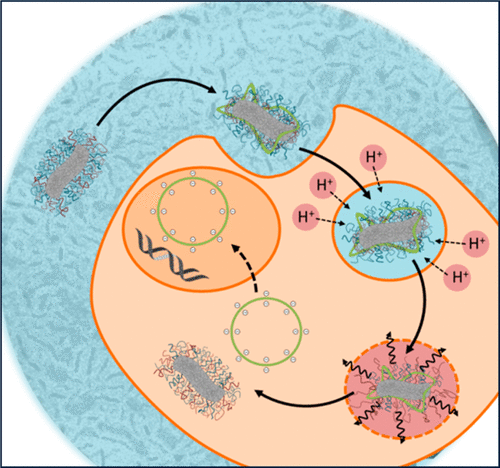当前位置:
X-MOL 学术
›
Biomacromolecules
›
论文详情
Our official English website, www.x-mol.net, welcomes your feedback! (Note: you will need to create a separate account there.)
How To Tune the Gene Delivery and Biocompatibility of Poly(2-(4-aminobutyl)-2-oxazoline) by Self- and Coassembly
Biomacromolecules ( IF 6.2 ) Pub Date : 2017-12-20 00:00:00 , DOI: 10.1021/acs.biomac.7b01535 Meike N. Leiske , Fabian H. Sobotta , Friederike Richter , Stephanie Hoeppener , Johannes C. Brendel , Anja Traeger , Ulrich S. Schubert
Biomacromolecules ( IF 6.2 ) Pub Date : 2017-12-20 00:00:00 , DOI: 10.1021/acs.biomac.7b01535 Meike N. Leiske , Fabian H. Sobotta , Friederike Richter , Stephanie Hoeppener , Johannes C. Brendel , Anja Traeger , Ulrich S. Schubert

|
Despite their promising potential in gene transfection, the toxicity and limited efficiency of cationic polymers as nonviral vectors are major obstacles for their broader application. The large amount of cationic charges, for example, in poly(ethylene imine) (PEI) is known to be advantageous in terms of their transfection efficiency but goes hand-in-hand with a high toxicity. Consequently, an efficient shielding of the charges is required to minimize toxic effects. In this study, we use a simple mixed-micelle approach to optimize the required charge density for efficient DNA complex formation and to minimize toxicity by using a biocompatible polymer. In detail, we coassembled mixed poly(2-oxazoline) nanostructures (d ≈ 100 nm) consisting of a hydrophobic-cationic block copolymer (P(NonOx52-b-AmOx184)) and a hydrophobic–hydrophilic stealth block copolymer (P(EtOx155-b-NonOx76) in ratios of 0, 20, 40, 60, 80, and 100 wt % P(NonOx52-b-AmOx184). All micelles with cationic polymers exhibited a very good DNA binding efficiency and dissociation ability, while the bio- and hemocompatibility improved with increasing EtOx content. Analytics via confocal laser scanning microscopy and flow cytometry showed an enhanced cellular uptake, transfection ability, and biocompatibility of all prepared micelleplexes compared to AmOx homopolymers. Micelleplexes with 80 or 100 wt % revealed a similar transfection efficiency as PEI, while the cell viability was significantly higher (80 to 90% compared to 60% for PEI).
中文翻译:

如何通过自组装和协同组装来调节聚(2-(4-氨基丁基)-2-恶唑啉)的基因传递和生物相容性
尽管它们在基因转染方面具有潜在的前景,但阳离子聚合物作为非病毒载体的毒性和有限的效率仍是其广泛应用的主要障碍。已知例如在聚(亚乙基亚胺)(PEI)中的大量阳离子电荷就其转染效率而言是有利的,但同时具有高毒性。因此,需要对电荷进行有效的屏蔽以使毒性作用最小化。在这项研究中,我们使用一种简单的混合胶束方法来优化所需的电荷密度,以有效地形成DNA复合物,并通过使用生物相容性聚合物将毒性降至最低。详细地说,我们coassembled混合的聚(2-恶唑啉)的纳米结构(d ≈100nm)的由疏水性阳离子嵌段共聚物(P的(NonOx 52- b -AmOx 184))和疏水性-亲水性隐形嵌段共聚物(P(ETOX 155 - b -NonOx 76)在0比,20,40,60,80,和100%(重量)P(NonOx 52 - b - AmOx 184)。具有阳离子聚合物的所有胶束都表现出非常好的DNA结合效率和解离能力,而生物相容性和血液相容性随EtOx含量的增加而提高。通过共聚焦激光扫描显微镜和流式细胞术进行的分析表明,与AmOx均聚物相比,所有制备的胶束复合物均具有增强的细胞摄取,转染能力和生物相容性。具有80或100 wt%的Micelleplexes显示出与PEI相似的转染效率,而细胞活力显着更高(80至90%,而PEI为60%)。
更新日期:2017-12-20
中文翻译:

如何通过自组装和协同组装来调节聚(2-(4-氨基丁基)-2-恶唑啉)的基因传递和生物相容性
尽管它们在基因转染方面具有潜在的前景,但阳离子聚合物作为非病毒载体的毒性和有限的效率仍是其广泛应用的主要障碍。已知例如在聚(亚乙基亚胺)(PEI)中的大量阳离子电荷就其转染效率而言是有利的,但同时具有高毒性。因此,需要对电荷进行有效的屏蔽以使毒性作用最小化。在这项研究中,我们使用一种简单的混合胶束方法来优化所需的电荷密度,以有效地形成DNA复合物,并通过使用生物相容性聚合物将毒性降至最低。详细地说,我们coassembled混合的聚(2-恶唑啉)的纳米结构(d ≈100nm)的由疏水性阳离子嵌段共聚物(P的(NonOx 52- b -AmOx 184))和疏水性-亲水性隐形嵌段共聚物(P(ETOX 155 - b -NonOx 76)在0比,20,40,60,80,和100%(重量)P(NonOx 52 - b - AmOx 184)。具有阳离子聚合物的所有胶束都表现出非常好的DNA结合效率和解离能力,而生物相容性和血液相容性随EtOx含量的增加而提高。通过共聚焦激光扫描显微镜和流式细胞术进行的分析表明,与AmOx均聚物相比,所有制备的胶束复合物均具有增强的细胞摄取,转染能力和生物相容性。具有80或100 wt%的Micelleplexes显示出与PEI相似的转染效率,而细胞活力显着更高(80至90%,而PEI为60%)。


























 京公网安备 11010802027423号
京公网安备 11010802027423号